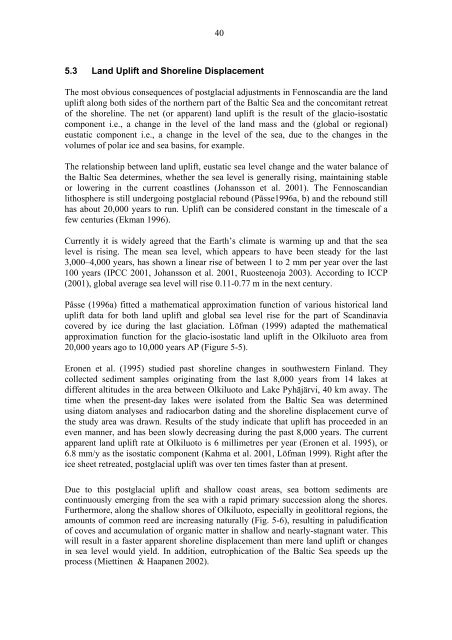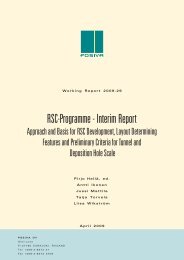Olkiluoto Biosphere Description 2006 (pdf) (4.1 MB) - Posiva
Olkiluoto Biosphere Description 2006 (pdf) (4.1 MB) - Posiva
Olkiluoto Biosphere Description 2006 (pdf) (4.1 MB) - Posiva
You also want an ePaper? Increase the reach of your titles
YUMPU automatically turns print PDFs into web optimized ePapers that Google loves.
405.3 Land Uplift and Shoreline DisplacementThe most obvious consequences of postglacial adjustments in Fennoscandia are the landuplift along both sides of the northern part of the Baltic Sea and the concomitant retreatof the shoreline. The net (or apparent) land uplift is the result of the glacio-isostaticcomponent i.e., a change in the level of the land mass and the (global or regional)eustatic component i.e., a change in the level of the sea, due to the changes in thevolumes of polar ice and sea basins, for example.The relationship between land uplift, eustatic sea level change and the water balance ofthe Baltic Sea determines, whether the sea level is generally rising, maintaining stableor lowering in the current coastlines (Johansson et al. 2001). The Fennoscandianlithosphere is still undergoing postglacial rebound (Påsse1996a, b) and the rebound stillhas about 20,000 years to run. Uplift can be considered constant in the timescale of afew centuries (Ekman 1996).Currently it is widely agreed that the Earth’s climate is warming up and that the sealevel is rising. The mean sea level, which appears to have been steady for the last3,000–4,000 years, has shown a linear rise of between 1 to 2 mm per year over the last100 years (IPCC 2001, Johansson et al. 2001, Ruosteenoja 2003). According to ICCP(2001), global average sea level will rise 0.11-0.77 m in the next century.Påsse (1996a) fitted a mathematical approximation function of various historical landuplift data for both land uplift and global sea level rise for the part of Scandinaviacovered by ice during the last glaciation. Löfman (1999) adapted the mathematicalapproximation function for the glacio-isostatic land uplift in the <strong>Olkiluoto</strong> area from20,000 years ago to 10,000 years AP (Figure 5-5).Eronen et al. (1995) studied past shoreline changes in southwestern Finland. Theycollected sediment samples originating from the last 8,000 years from 14 lakes atdifferent altitudes in the area between <strong>Olkiluoto</strong> and Lake Pyhäjärvi, 40 km away. Thetime when the present-day lakes were isolated from the Baltic Sea was determinedusing diatom analyses and radiocarbon dating and the shoreline displacement curve ofthe study area was drawn. Results of the study indicate that uplift has proceeded in aneven manner, and has been slowly decreasing during the past 8,000 years. The currentapparent land uplift rate at <strong>Olkiluoto</strong> is 6 millimetres per year (Eronen et al. 1995), or6.8 mm/y as the isostatic component (Kahma et al. 2001, Löfman 1999). Right after theice sheet retreated, postglacial uplift was over ten times faster than at present.Due to this postglacial uplift and shallow coast areas, sea bottom sediments arecontinuously emerging from the sea with a rapid primary succession along the shores.Furthermore, along the shallow shores of <strong>Olkiluoto</strong>, especially in geolittoral regions, theamounts of common reed are increasing naturally (Fig. 5-6), resulting in paludificationof coves and accumulation of organic matter in shallow and nearly-stagnant water. Thiswill result in a faster apparent shoreline displacement than mere land uplift or changesin sea level would yield. In addition, eutrophication of the Baltic Sea speeds up theprocess (Miettinen & Haapanen 2002).
















